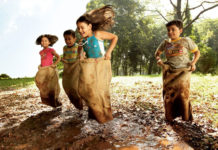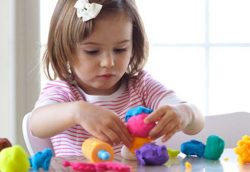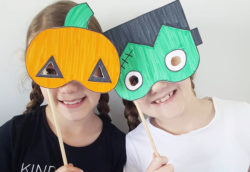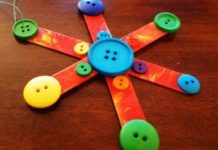Have you heard of the STEM craft activities for kids? It is about indulging the kids in the “Science, Technology Engineering and Math” craft activities that push them to prepare in these areas from early childhood. It helps the kids to gather the right educational information and interest via fun activities.
Helping kids to explore, observe, ask questions and predict the outcome by integrating their learning via these stem craft ideas, is the best way to teach them. Doing the things that are available in front of you is the best advantage of these stem art projects. Let the kids explore, test and try. Allowing the kids to use natural curiosity, they put ideas into actions and discover more.
Stem Crafts for kids:
1. A Secret Message with an Invisible Ink:

When life gives lemons, you make invisible ink to write secret messages. Interesting, isn’t it? All you need is a lemon, cotton swab, a sheet of paper to write and sun, iron or light bulb. This science craft for kids is super fun.
- Squeeze a lemon into a bowl and add a spoon of water. Dip the swab after mixing the mixture in the bowl, and write a message or draw on the paper.
- Allow it to dry for the message or picture drawn to go invisible. Share your secret with your friend.
- To decode the secret message, keep the picture in sunlight or hold it close to the light bulb or iron over it (with the help of adults) to reveal the message. You can hang it like artwork or keep it safe with you hidden.
How does it work? The science behind this is – By adding water to the lemon juice, it gets diluted making it very hard to see when you apply on the paper. However, lemon is an organic substance which gets oxidized when heated up turning brown. Thus no one will ever see there is a message on the paper drawn until the paper is heated up. Similarly, the other thinks that acts the same way as lemon did in this experiment is – honey diluted with water, milk, onion juice, orange juice, vinegar. Doesn’t this make a brilliant science craft for kids?
2. Interesting Bath Bombs:

Make the bath time fun with some science fun to the tub by adding the pretty bath bombs. You will need only basic simple items from the kitchen for this experimental fun.
- Half cup citric acid, a cup of baking soda, half cup of corn starch, half cup of Epsom salt, essential oil of your choice, one teaspoon water and one teaspoon olive oil.
- Combine the citric acid with baking soda and corn starch in a bowl. Add the Epson salt and mix well. Take another small bowl and mix together one or two drops of essential oil with water and olive oil.
- Add the wet mixture to the dry slowly while whisking it. It should mix together properly thoroughly to avoid any bubbles. Once done, let the mixture sit for a couple of minutes to look like wet sand. If it looks dry, feel free to add some oil drops (olive or coconut) to it.
- Separate the mixture into smaller bowls and mix with food color of your choice.
- Now, in the mould, layer the different colors of the mixture to stuff and press it together and gently lock the mould. Let it dry in the mould for a few minutes and then carefully remove it from the mould after an hour or two to have a fun bath the next day.
How does it work? The fizzy reaction in the tub due to the bath bomb is created because of the sodium bicarbonate content of the baking soda and citric acid. The citric acid which is acidic in nature and baking soda is a base. Although nothing happens when you mix them dry, but when it has water as the medium, the ions in each collides, water acting as a catalyst. It dissolves in the water with tiny bubbles of carbon dioxide gas. The bomb breaks down hence releasing the scent. No wonder, we all love science!
3. Tornado in a jar:

This is one of the most straightforward science craft for the kids to feed their curiosity about the happenings around. Tornado is very common in the US, and we keep hearing about it. But does your kid know what is it and how it occurs? Explain to them with this simple experiment of Tornado in a jar.
- You will need a glass or a plastic jar (Mason jar or any), dish soap, vinegar and food color with some glitters.
- Add some few drops of dish soap and food coloring in the bottom of the jar. Fill the jar with 3/4 water and add a teaspoon of vinegar.
- Add some glitters and put the lid on the jar and secure it.
- You can swirl the jar in a circular motion to see the tornado set in and appear in the jar when stable.
How does it work? The tornado forms when the fluid on the outside of the jar starts spinning before the fluid at the centre. When you set the jar down, the fluid outside is slowing down the fluid inside the jar which continues to spin faster. What you see is the formation of a vortex, where the water spins rapidly around the vortex due to centripetal force inwards and directing the objects and fluid towards the centre of the jar.
4. Balancing Cork:

This balancing buddy will be your kid’s best friend when they are amused to see the silly pal teeter on the tiny toothpick point.
- You need a wine cork, two 12-inch bamboo skewers, toothpick, modeling clay and decorations like paper, wiggly eyes, paint etc.)
- Take the cork and place it upright on the surface such that you can press the pointy edge of the skewer onto the top surface of the cork. Make sure to do it at an angle of 45 degrees and the ends pointing up. Repeat this on the opposite end but again be careful with the angle. Press the toothpick into the top centre of the cork.
- Roll two small balls of modeling clay to make it as the feet by pressing them to the ends of the skewers. Decorate the cork with wiggly eyes and what you desire.
- Place the tip of the toothpick on your finger and see it well balanced on that little tip. If it bends to one side, adjust the angles of the skewers until they stand upright.
How does it work? The science behind this is all about the centre of gravity. The centre of gravity for this balancing friend of yours is brought to the bottom of the toothpick by the clay balls which are heavier than the cork. Thus the point where the mass is evenly distributed helps the toy to stand the weight of the ball by balancing it.
5. Yard stick launcher for the kids to play:

Want your kids to have fun while stomping the foot? Help them with this simple activity of stem craft and see them jump in joy.
- You will need a clean metal can (like a coke can etc.), scrapbook paper, tape, yardstick, paint and brush, hot glue, 4 plastic cups, 4 ping-pong balls and rubber band.
- Paint the yardstick with a brush and allow it to dry.
- Cover the can with the scrapbook paper and secure with a tape.
- Use the hot glue gun to fox the plastic cups to one end of the yardstick and secure the can to the middle of the yardstick with a rubber band.
- Place the ping-pong balls in each of the cups such that you stomp on the free space of the yardstick strongly to see the ball launch in a projectile motion across the room.
How does it work? This is a lever action where the rigid beam made using the yardstick acts with the fulcrum cans. The logic works when the kid applies pressure from one side forcing it down with a sudden jerk, the unattached load which is the ball, in this case, jumps and flies. This force has an opposite reaction making the projectile motion of the balls. The force can be changed to change the projectile along with the object can be moved closer to move the projectile.
6. Engineering with Candy:

How about your kid building structures out of toothpicks and knowing acquiring some engineering skills? This is a very simple STEM craft idea for kids where they can use the basic things to build a structure and experiment.
- You need toothpicks and gummy candies or marshmallows.
- Toothpicks are to be connected with each other using a marshmallow or gummy bear in between and the kid needs to be challenged by the parents or teachers to make the tallest structure or build until they fall.
How does it work? This is as simple as applying their engineering skills by trying different shapes to make a structure. Be it wide or sleek; there will be a limit the structure falls off because of lack of support etc. Thus, the kids experiment with the structures especially if they have to make the tallest building with the least possible toothpicks.
7. Greater than or smaller than:

The cutest and the easiest Math crafts are right here to teach your little one the world of numbers.
- You will need a paper, pencil, paint and scissors and maybe fruits or any objects that you would like to quantify.
- Make an alligator mouth on the paper with a pencil such that it is just an angular rectangles with some spiky triangular tooth inside the “V” shape. Look at the picture and replicate the design.
- Make some wiggly eyes with circular paper and complete the detailing with color sketch pens or paint.
- Once done, it is time to play and learn! Use the fruits of same type and place is on the table. Ask the kid which one will the alligator eat? (Obviously, the one that is plenty in number). Once they learn that, write numbers on the paper and use it again to teach the numbers.
How does it work? This is as simple kid seeing the objects and knows which is in plenty in his head. Children can practice greater than and lesser than with this strategy easier than just memorizing the words in the head.








































